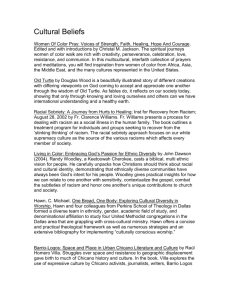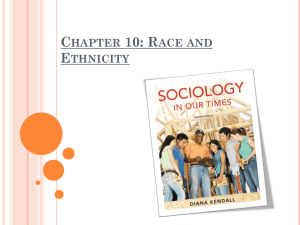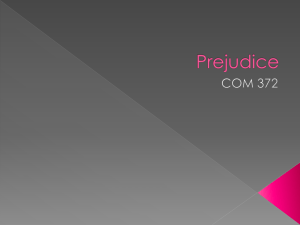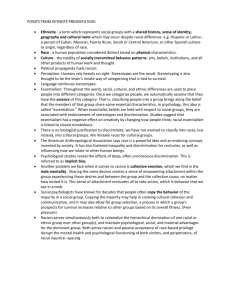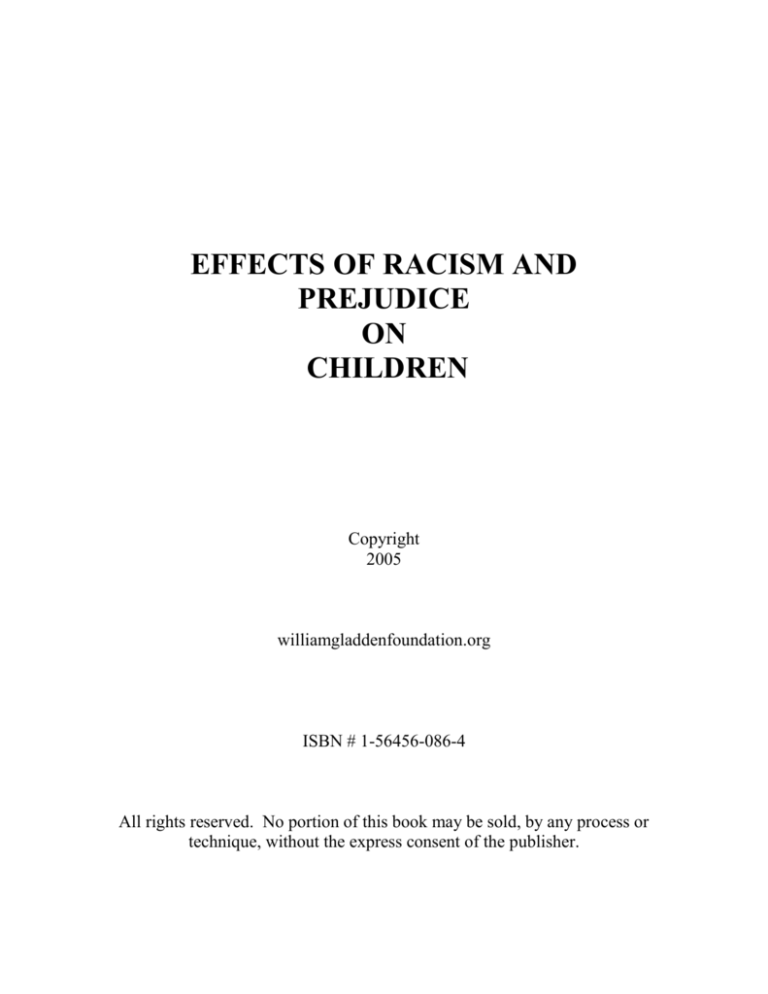
EFFECTS OF RACISM AND
PREJUDICE
ON
CHILDREN
Copyright
2005
williamgladdenfoundation.org
ISBN # 1-56456-086-4
All rights reserved. No portion of this book may be sold, by any process or
technique, without the express consent of the publisher.
INTRODUCTION
Today, perhaps more than ever, America is a nation of racial and ethnic diversity. For
example, the 1980s and 1990s saw a huge increase in the number of Hispanics and
Asians who immigrated to the United States and changed the complexion of our society.
Furthermore, indications suggest that the trend toward racial and ethnic diversity will
continue.
Because of the dramatic change in America’s population, it is likely that when children
go to school, the mall or the park, they will meet children who are racially or culturally
different. These differences may be visible in skin color, hair texture, dress or some
combination of these or other characteristics. Unfortunately, racism and prejudice too
often influence how children relate to people they view as different.
Racism and prejudice are based on exaggerated myths and stereotypes. AfricanAmericans, for instance, are particularly victimized by racism and prejudice. During the
time of slavery, many white Americans considered Africa the “dark continent,” inhabited
by savages who needed rescued from their wicked ways by Christians. These types of
myths and stereotypes formed the basis for racism and prejudice against Africans and
served to justify the indignity and harsh treatment imposed upon them during slavery.
Despite the passing of more than 300 years, the numerous contributions of AfricanAmericans to society, the passing of the Civil Rights Act, and continued efforts to
eliminate institutional racism, many myths and stereotypes still form the basis for racism
and prejudice against people of African descent.
-II-
Myths and stereotypes exist not only for African-Americans but also for many other
American ethnic and racial groups such as Jewish-Americans, Italian-Americans, AsianAmericans, Mexican-Americans and Puerto Rican-Americans. Myths and stereotypes
cannot be ignored. They form the very basis of racism and prejudice and affect how
children of different racial and ethnic backgrounds relate to one another.
Prejudiced children have a self-imposed limitation on their educational, social and
political development. Prejudice interferes with the learning and development of healthy
relationships and can lead to psychological, social or physical harm to others. In essence,
the effects of racism and prejudice on children affect both individual and societal
potential, thus limiting us all.
Warren A. Rhodes, Ph.D.
Marlene Saunders, MSW
Marylee Saunders
William Gladden Foundation
-III-
TABLE OF CONTENTS
QUESTIONS AND ANSWERS
What Is Race?......................................................................................................................5
What Is An Ethnic Group?...................................................................................................5
What Is Racism?..................................................................................................................5
What Is Individual Racism?.................................................................................................5
What Is Institutional Racism?..............................................................................................6
What Is Cultural Racism?....................................................................................................6
How Do Racism And Prejudice Differ?..............................................................................6
What Is Wrong With Racism And Prejudice?.....................................................................6
What Are Some Signs Of Racism And Prejudice In Children?..........................................7
When Do Children Become Aware Of Ethic Differences?.................................................7
How Do Victims Of Racism And Prejudice React?............................................................7
How Do Racist And Prejudiced Victimizers React?...........................................................7
How Do Parents Promote Racism And Prejudice?..............................................................8
How Do Peers Promote Racism And Prejudice?.................................................................8
How Does Television Promote Racism And Prejudice?.....................................................8
How Do Books Promote Racism And Prejudice?...............................................................8
Is Racial And Ethnic History Important?............................................................................9
Does Racism And Prejudice Affect Learning?...................................................................9
Can Children Be Free Of Racism And Prejudice?..............................................................9
How Can Children Combat Racism And Prejudice?..........................................................9
EFFECTS OF RACISM AND PREJUDICE ON CHILDREN…..……………….…10
EXAMPLES OF RACISM AND PREJUDICE…………………………..…………..12
HOW PARENTS CAN PROMOTE POSTIVE RACIAL
AND ETHNIC ATTITUDES IN CHILDREN………………………….................14
HOW EDUCATORS CAN PROMOTE POSITIVE RACIAL
AND ETHNIC ATTITUDES IN CHILDREN……………………..…..…………15
SOURCES TO CONTACT ABOUT RACISM AND PREJUDICE…….………....16
-IV-
WHAT IS RACE?
The term “race” once referred to people with a common heredity. Physical
characteristics were used to distinguish between races. However, classifying people by
factors such as skin color, hair texture or facial features is not always accurate in modern
American society. Rather, race has become more of a social term than an accurate way
of describing biological differences between people.
WHAT IS AN ETHNIC GROUP?
An “ethnic group” is a subgroup of a larger society. Cultural or racial characteristics
make ethnic groups different from the majority of society. For example, JewishAmericans have unique cultural characteristics such as observation of Passover and Yom
Kippur. Most African-Americans also have distinct cultural and physical characteristics
such as dark skin and the cultural significance of music and the extended family. JewishAmericans and African-Americans represent two distinct ethnic groups.
WHAT IS RACISM?
Racism is an ideology that supports racial oppression or exploitation, based on beliefs of
a particular race’s cultural or natural inferiority. Such beliefs justify and sustain the
unequal or inferior treatment of a particular group. There are three forms of racism:
individual, institutional and cultural.
WHAT IS INDIVIDUAL RACISM?
“Individual racism” refers to a person having negative thoughts or feelings or exhibiting
such behaviors toward another person based on race. In most cases, people who
demonstrate this form of racism do so because they believe their race is superior to
another race. For example, a mother is encouraging individual racism if she forbids her
daughter to play with a Mexican-American child because of racial stereotypes.
-5-
WHAT IS INSTITUTIONAL RACISM?
“Institutional racism” refers to educational, economic, social or political organizations
that deliberately or unintentionally support racial inequality. For example, a school that
does not admit African-American children is practicing institutional racism.
WHAT IS CULTURAL RACISM?
“Cultural racism” refers to beliefs, feelings and behaviors of member of one racial or
ethnic group who claim that their contributions to society are superior to those of another
group. An example of cultural racism would be the contention that Europeans are
responsible for developing all the major inventions of modern civilization. Such a belief
undermines the important contributions of other racial and ethnic groups such as
American Indians, Arabs, Asians and other cultures.
HOW DO RACISM AND PREJUDICE DIFFER?
Both racism and prejudice refer to an unfavorable attitude, feeling or behavior based on
myths and stereotypes. Prejudice, however, is a broader terms than racism. People can
be prejudiced against other people because of gender, age, religion or other such factor.
For instance, heterosexuals are sometimes prejudiced against homosexuals because of
differing sexual attitudes and behaviors.
WHAT IS WRONG WITH RACISM AND PREJUDICE?
Racism and prejudice impede human potential. Young victims of racism and prejudice
are more likely to have low self-esteem, poor self-concept, and limited aspirations and,
accordingly, are less likely to be successful in school, work or play. Conversely, in our
increasingly racially and ethnically diverse society, children with racist attitudes may find
themselves at a social, educational and political disadvantage. In essence, racism and
prejudice threaten the development of both the victim and the perpetrator.
-6-
WHAT ARE SOME SIGNS OF RACISM AND PREJUDICE IN CHILDREN?
Racism and prejudice are expressed in many ways, some directly and others indirectly.
The following are just a few examples of racist expressions and prejudiced actions: 1) not
wanting to attend a school where the majority of students belong to another racial or
ethnic group; 2) excluding or inciting hostility against members of other racial or ethnic
groups; 3) making general statements about a racial or ethnic group based on an
experience with one member of that group; and 4) referring to another child by a negative
racial slur like “Nigger,” “Wop,” “Kike” or “Spic.”
WHEN DO CHILDREN BECOME AWARE OF ETHNIC DIFFERENCES?
Basic social attitudes develop in early childhood. In fact, children can differentiate
between people at a very early age. Once children can differentiate between people, they
can be taught (intentionally or unintentionally) to respond positively or negatively based
on those differences. For example, research shows that children as young as two can
identify people by whether they are black or white. Research also shows that white
children as young as four generally hold negative attitudes toward other racial groups,
and that black children as young as three harbor negative views about white people.
HOW DO VICTIMS OF RACISM AND PREJUDICE REACT?
Children who are victims of racism and prejudice may react in any one of the following
ways: 1) accept the stereotype and develop a sense of inferiority, 2) act-out the
stereotype, 3) reject his or her ethnic inferiority or 4) develop hatred or resentment
toward the perpetrator.
HOW DO RACIST AND PREJUDICED VICTIMIZERS REACT?
Prejudice and racism give perpetrating children a false sense of security and superiority.
Their inflated sense of self-esteem may eliminate any guilt that would be normally
associated with the negative attitudes, feelings and behaviors. An otherwise normal child
who is racially prejudiced can be a real threat to another child whom he or she perceives
as racially inferior.
-7-
HOW DO PARENTS PROMOTE RACISM AND PREJUDICE?
Children tend to follow their parents’ instructions. Studies show that in some cases
parents directly instruct their children concerning racist and prejudiced attitudes. For
example, one study showed that almost 50% of white families in the sample told their
children not to play with African-American youngsters. Furthermore, racial prejudice
can be communicated indirectly or directly, intentionally or unintentionally, by doing
such things as associating black with “bad” or white with “good.” Studies show that such
associations strengthen negative attitudes toward African-Americans.
HOW DO PEERS PROMOTE RACISM AND PREJUDICE?
Some studies indicate a strong relationship between adolescents’ racial attitudes and the
attitudes of their friends. This finding is important because as children grow older, the
influence of their friends grows in strength and significance. For example, a group of
teenagers who pressure another child not to associate with an Asian-American student
because he is “yellow,” “slant-eyed” or “too smart” is promoting racial prejudice.
HOW DOES TELEVISION PROMOTE RACISM AND PREJUDICE?
Television plays a major role in forming the racial attitudes of children. Programs that
uphold stereotypes (such as Hispanics portrayed as servants, prostitutes, drug dealers or
gang members) promote prejudiced attitudes and behaviors. On the other hand, programs
that go against stereotypes (such as African-Americans portraying doctors, lawyers or
teachers) can help counter them.
HOW DO BOOKS PROMOTE RACISM AND PREJUDICE?
Books that ignore people of color or non-Western cultures suggest their lack of worth.
Such books also deprive non-white children of role models. For example, books that do
not include examples of African-Americans, Asian-Americans or Hispanics in socially
desirable roles suggest that these ethnic groups are not valued in society.
-8-
IS RACIAL AND ETHNIC HISTORY IMPORTANT?
All racial and ethnic groups have rich histories. Research shows that knowing the
struggles, triumphs and accomplishments of their ethnic group can have a positive impact
on children in all areas of life. History can give children a frame of reference and role
models to emulate. History can inspire dreams, stimulate pride in oneself and one’s
heritage and provide the foundation for excelling.
DOES RACISM AND PREJUDICE AFFECT LEARNING?
Racism and prejudice damage how children feel about themselves and other members of
their group, including family members. Children who accept that they are inferior have
poor self-esteem, a personal characteristic extremely important for succeeding in school
and in life in general.
CAN CHILDREN BE FREE OF RACISM AND PREJUDICE?
Unfortunately, nearly all American children are at least a little prejudiced. This is true
because most children are exposed to prejudiced thinking and behaviors from parents,
peers, the media and other sources. Until the individuals and institutions responsible for
educating our children provide the public with correct information and positive images
regarding racial and ethnic groups, children will continue to be exposed to and
susceptible to racism and prejudice.
HOW CAN CHILDREN COMBAT RACISM AND PREJUDICE?
Whether or not a child develops racist and prejudicial attitudes greatly depends on how
he or she is socialized. Children who interact with other children belonging to different
racial and ethnic groups, and who are involved in activities that give them accurate
information about cultural diversity, tend to develop sensitivity to ethnicity. In turn,
these children are able to form their own opinions directly from their personal
experiences, rather than have their opinions molded by myths and stereotypes.
-9-
EFFECTS OF RACISM AND PREJUDICE
ON CHILDREN
Children are aware of racial differences as early as age three. Furthermore, prejudices
developed in childhood tend to carry-over to adulthood, and prejudices carried-over to
adulthood are often transferred to the next generation. Therefore, the effects of racism
and prejudice can be both immediate and long-term.
(PLACE DIAGRAM HERE)
AWARENESS OF RACIAL CUES – Between three and four years of age, children
become aware of racial differences according to physical characteristics. For example,
they see differences in skin, hair and eye color.
-10-
ATTITUDES TOWARD RACE AND ETHNICITY FORMING – Between five and
seven years of age, children begin to form attitudes toward racial or ethnic groups. For
example, a white child may view African-Americans as “bad” because they are darkskinned and Japanese-Americans as “soot” because they are light-skinned.
ATTITUDES TOWARD RACE AND ETHNICTY BECOMING FIXED – From age
eight onward, attitudes toward racial and ethnic groups become increasingly more
consolidated. For example, an African-American child who has been repeatedly called a
“Nigger” by white youths or barred from their activities may begin to view white people
as racists.
NEGATIVE DEVELOPMENTAL OUTCOMES – The child develops a negative
attitude toward certain racial and ethnic groups. He or she avoids interacting with
members of these groups and becomes a racist/prejudiced adult. If not corrected, these
attitudes remain fixed into adulthood and are difficult to change.
ATTITUDES TOWARD RACE AND ETHNICTY TRANSFER TO THE NEXT
GENERATION – Childhood attitudes regarding racism and prejudice that are carriedover into adulthood are easily transferred to the next generation. Racist and prejudiced
mothers and father tend to influence their child’s attitudes about race and ethnicity by
perpetuating the exaggerated myths and stereotypes they accepted from childhood
onward. This intergenerational cycle of racism and prejudice negatively affects the
victim and the perpetrator by limiting their understanding of each other and their
potential to find common ground.
-11-
EXAMPLES OF
RACISM AND PREJUDICE
Racist and prejudiced acts or statements can be quite subtle or unashamedly blatant. An
act or statement is judged racist or prejudiced if it is denigrating or undermining,
regardless of whether the act or statement is subtle, unconscious or unintentional. While
it is nearly impossible to detail all the different ways in which racism and prejudice may
be revealed, the following list includes some typical examples.
Purposely avoiding or ignoring a person of another race or ethnic group
Using code words like “busing,” “inner-city” or “welfare mothers” to camouflage
one’s attitudes and feelings about certain groups
Opposing zoning permits for housing in one’s community that will be occupied
by minority groups
Referring to ethnic groups as “them” or “you people”
Believing that all people in a particular ethnic group are naturally gifted as
athletes, dancers, comedians, doctors, accountants, etc
Talking down to people who belong to certain ethnic groups because of a
perception that they lack communication skills
Questioning or doubting the abilities, integrity or motives of another solely
because of that person’s race or ethnicity
Discounting or ignoring ideas or contributions solely because their source is an
individual of another race or ethnicity
Organizing group social events in such a way as to specifically exclude group
members who are racially or ethnically different from the majority
Judging other racial groups more harshly than one’s own for the same act
“Red-lining” practices” employed by banking, insurance or realty companies to
enforce geographical separation of racial or ethnic groups
Withholding or rendering inferior goods or services based solely on the
recipient’s race or ethnicity
Devaluing good and services that are provided by another based solely on the
person’s race or ethnicity
-12-
A salesperson serving a person of one race or ethnic group first despite the fact
that a person of another race or ethnic group had been waiting longer
Making statements like “Your people are good at…”
Implying that the property owned by certain racial or ethnic groups was acquired
through illegal or unethical means
Refusing to accept the importance of racial or ethnic traditions
Promoting the notion that certain ethnic or racial groups are intellectually or
culturally inferior to others
Denying members of certain racial or ethnic groups admission to clubs and
organizations
Relegating members of certain racial or ethnic groups to menial employment or
under-employment
Using code words to identify minority job applicants
Being unwilling to allow a member of your family to date or be friends with
someone based solely on race or ethnicity
Blaming a particular race or ethnic group for social or economic problems
Promoting the concept that property values decline when certain racial or ethnic
groups move into a neighborhood
Clustering students in schools, classrooms or activities based solely on race or
ethnicity
Believing that certain racial or ethnic groups are naturally more aggressive than
others are
Devaluing the life and well-being of racial and ethnic group members
Asking racial or ethnic group members to show identification when others are not
required to do so
Promoting the idea that all members of a racial or ethnic group look alike
Supporting the belief that one racial or ethnic group is biologically superior to
another
-13-
HOW PARENTS CAN PROMOTE POITIVE
RACIAL AND ETHNIC ATTITUDES IN CHILDREN
The family is the primary institution responsible for socializing children. Therefore,
parents have the important duty of helping their offspring learn to relate to a variety of
people. Here are several approaches parents can take that will help their children
understand and appreciate racial and cultural diversity.
ADMIT PREJUDICE – By denying their own prejudice, parents will very likely
communicate negative racial attitudes, even if they do not intend to do so. To determine
if they are ethnically biased, parents can answer these questions: Do members of a
particular ethnic group all look alike to you? Would you be upset if your child attended a
school where your ethnic group did not comprise the majority of the student body? Do
you make sweeping generalizations about a particular racial or ethnic group? A “yes”
answer to any of these questions indicates prejudicial attitudes toward people who are
different.
OBSERVE DIVERSITY – Parents can help their children understand and appreciate
cultural diversity by promoting interaction with children from different cultures. If their
children’s activities are limited to one cultural group, they might get them involved in
mixed cultural groups.
PROTEST DISCRIMINATORY ACTIONS – Parents should not allow their children
to make comments or engage in behaviors that are racist or prejudiced. If one of their
children refers to Maria as a “Wop,” the parents should immediately state that such
language is unacceptable. They should also explain that Maria is Italian-American and
that “Wop” is a mean way of referring to someone of Italian heritage.
ENCOURAGE SENSITIVITY – Children who can empathize with victims of racism
and prejudice are less likely to engage in bigotry. Research shows that children as young
as five can identify someone whose feelings have been hurt. Whether a child is five or
fifteen, he or she is capable of connecting emotionally with a Chinese youngster who was
called a “Chink.” In the case of a young child, compare the feelings of a victim of
prejudice to a situation that made him or her sad.
SET AN EXAMPLE – Parents should avoid making comments that reinforce myths or
stereotypes. Rather, they should show their children, both through words and deeds, that
all people are to be treated with respect and dignity.
-14-
HOW EDUCATORS CAN PROMOTE POSITIVE
RACIAL AND ETHNIC ATTITUDES IN CHILDREN
How educators address ethnic diversity, racism and prejudice helps shape their students’
attitudes toward others who are ethnically different. Therefore, teachers should learn
how to ensure that their students’ learning experiences promote understanding respect for
ethnic diversity.
Consider your knowledge of the history and development of various racial and
ethnic groups in the United States and the world. To teach students accurately
about cultural diversity, racism and prejudice, educators must know the facts.
Examine textbooks that address ethnic and cultural diversity to ensure they
contain information that is accurate and complete. If uncertain about the quality
of a text, consult an expert in the field of cultural diversity and children.
Review textbooks to ensure that they do not reinforce myths and stereotypes.
Use textbooks that describe why people have different physical characteristics.
Give assignments that offer students the opportunity to discover information
about different ethnic groups. For example, ask them to point out Africa on a
map or compare the size of Asia to the United States.
Give assignments that promote interaction between students who are ethnically
different. For example, assign students to project groups so that the groups are
ethnically diverse.
Develop lesson plans that include descriptions and discussions of specific
examples of racism and prejudice. For example, a class can focus on Apartheid.
Take students to museums that depict and describe different cultures.
Plan lessons that focus on ethnic diversity issues that are specific to your
community. For example, if your community has experienced racial tension,
lessons should focus on events leading to the conflict, the participants and their
roles in the situation. Allow the students to express their ideas about what should
happen to resolve the problem(s).
Stimulate classroom discussions by scheduling guest lecturers who are
knowledgeable about racism and prejudice. This strategy will give students an
opportunity to hear different viewpoints, express their opinions and ask questions.
-15-
SOURCES TO CONTACT ABOUT
RACISM AND PREJUDICE
Racism and prejudice are complex issues and, as such, can be difficult to explain to
children. Recruiting the expertise of resources experienced in teaching children about
racism and prejudice is usually best. In fact, to do otherwise may result in more harm
than good. The following national resources may provide speakers, specialized literature,
audio or video tapes that are useful for introducing children to race, ethnicity and cultural
diversity.
The Prejudice Institute
www.prejudiceinstitute.org
National Association for the Advancement of
Colored People (NAACP)
www.naacp.org
The National Conference for
Community and Justice
www.nccj.org
Anti-Defamation League
www.adl.org
National Association for the Education of
Young Children
www.naeyc.org
World Racism
www.worldracism.com
World Against Racism
www.endracism.org
-16-


